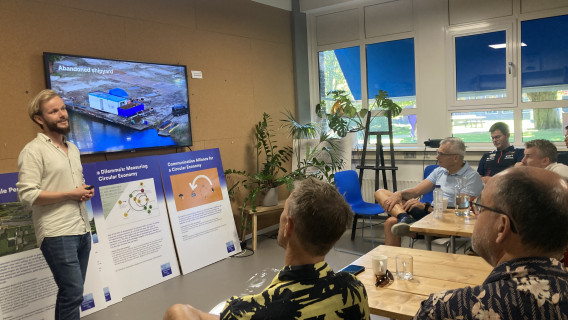On Thursday, September 7, Amsterdam Smart City hosted a knowledge exchange for a delegation of leaders and CEOs from Denmark’s construction sector. The exchange was part of a study program organized by the Construction Section of the Confederation of Danish Industry in partnership with the Danish Embassy in The Hague, to help transfer Dutch best practices for circular construction to Denmark.
The exchange provided an opportunity for Dutch and Danish colleagues to learn from each other’s experiences on how to transition the construction sector to a more sustainable state. This is imperative since the construction sector is responsible for approximately 10% of CO₂ emissions, and a third of all waste streams in both countries. At the same time, both countries have high ambitions for transitioning to sustainability: the Netherlands aims to transition to a fully circular economy by 2050, while Denmark aims to reduce greenhouse gas emissions by 70% by 2030.
After an introduction to the Amsterdam Smart City program, Merlijn Blok from Metabolic shared the experience of Amsterdam in transitioning to a circular built environment. Merlijn highlighted several projects and best practices including:
- De Ceuvel: In 2012, Metabolic teamed up with a group of architects to develop a former polluted shipyard into a “clean technology playground” by repurposing discarded house boats into workspaces for creative entrepreneurs. The project fused sustainability, technology, and art, firmly planting the seed for more creative and circular area developments in Amsterdam North and beyond.
- Schoonschip: Building on the experience and lessons from De Ceuvel, Metabolic got involved in a community-driven project that aimed to build a sustainable floating community. Driven entirely by future residents, Schoonschip was built with a high ambition of circularity, with special attention paid to biobased materials which are key to reducing the environmental footprint of construction projects.
- Roadmap Circular Land Tendering: Scaling up isolated circular construction projects requires dedicated instruments to stimulate, measure and mandate circularity in the built environment, for instance through procurement. The Roadmap Circular Land Tendering is one of city of Amsterdam’s main instruments embedding the principles of circular construction in tender procedures. With it, the city of Amsterdam wants to contribute to the development of a national standard for circular building.
Central to the discussion was the question of how to move beyond ambitions towards making concrete and measurable progress on circularity in the built environment. On this topic, it was inspiring to learn from the Danish experience. The delegates shared that the Danish government has developed a “National Strategy for Sustainable Construction” which limits the CO₂ emissions permitted in construction projects, with new requirements being phased into the building code in 2023. The regulations apply to new buildings of more than 1,000 m2 and set a limit of 12kg CO₂-eq/m2/year based on Life Cycle Assessment (LCA) over 50 years. This limit is expected to be tightened in the upcoming years, thereby forcing the construction sector to incrementally decarbonize over the next decade. Such mandates are foreseen but not yet implemented in the Netherlands, providing an opportunity to learn from Denmark’s trailblazing approach. However, the Danish colleagues already shared some words of caution if Netherlands should adopt a similar approach: since the Danish regulation limits CO₂ impact per square meter, the regulation does little to incentivize construction of smaller dwellings which is one of the most important, though often overlooked measures in reducing the impact of the construction sector. As Danish colleagues explained, the overarching trend in Denmark is towards construction of larger dwellings, which is fundamentally at odds with the country’s sustainability goals. Other mechanisms are therefore needed to mandate more compact development.
The exchange provided valuable insights and cross-pollination of approaches between Danish and Dutch colleagues on a topic central to the transition to the circular economy. As leaders in the sustainability transition, the Netherlands and Denmark have a tremendous opportunity and responsibility to showcase the way to circular construction and to help scale this approach internationally.
<em>Are you working on innovative and transferable policies which can accelerate the transition to circular construction and sustainable built environment? Or do you have a circular project or challenge you would like to share with the Amsterdam Smart City network? Share your reflections and experiences in the comments below or send an email to noor@amsterdamsmartcity.com to discuss possibilities for collaboration.</em>





